CAN Europe sent a first letter to members of the Environmental (ENVI) and Industry (ITRE) committees of the European Parliament to start our lobbying efforts on the ETS post 2020 reform:
Dear ITRE and ENVI member,
Climate Action Network (CAN) Europe – a coalition of over 130 non-governmental organisations representing more than 44 million citizens, would like to inform you about our priorities related to the revision of the Emission Trading Scheme (ETS).
Yesterday the European Commission released its draft proposal on the post-2020 Emission Trading Scheme reform . The ETS just turned ten years old but it has still not delivered on its goal to facilitate the transition towards a renewable and energy efficient economy. Because of very weak reduction targets a massive oversupply of pollution permits has accumulated and carbon prices are now so low that they do nothing to cut emissions in Europe. The proposed revisions would not solve these problems. We are therefore looking to you to submit amendments to strengthen the revisions:
Climate ambition needs to be raised
The ETS revision must include the permanent cancellation of the 2.5 to 4.5 billion surplus allowances that will have accumulated by 2020. These are left over pollution permits that will not be used but can, according to current rules, be carried over to after 2020, increasing the total amount of greenhouse gases that can be emitted after 2020. Permanent cancellation of the surplus would help ensure that the EU’s climate targets are met by actual emission reductions rather than with left over surplus.
The ETS Directive should include language that requires the Commission to upwardly increase the ETS target every 5 years (e.g by raising the linear reduction factor). This would be in line with the international review cycles proposed for the new UNFCCC climate deal Paris agreement.
Industry handouts and windfall profits have to stop
The success of the ETS revision hinges on its ability to make the polluter pay, rather than paying the polluter. Generous exemptions in the form of free pollution permits have led to windfall profits for large energy intensive companies on the backs of EU citizens.
The Commission’s proposal would hand out over 6 billion free pollution permits, worth € 80-200 billion to subsidize carbon pollution of industry and power plants from 2021-2030. This is unacceptable. The criteria that define if an industry has a competitive disadvantage due to the ETS (carbon leakage risk) must be strengthened significantly.
ETS climate finance must increase
Auctioning of ETS allowances has to be maximized and auctioning revenue should be used instead to fund more emission cuts and to support adaptation to an already changing climate, including in developing countries.
The ETS reform is an opportunity for the EU to restore its international leadership in climate action. Requiring that part of the ETS revenues are used for climate protection in poor countries would help overcome roadblocks to a meaningful international climate agreement in Paris this December.
We will follow up with a more detailed analysis of the proposal and suggested amendments. In the meantime please do not hesitate to contact us if you have questions or comments.
Yours sincerely,
Wendel Trio, Director – Climate Action Network Europe
Contact:
Anja Kollmuss
EU Climate Policy Coordinator, Climate Action Network Europe
anja@caneurope.org



